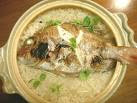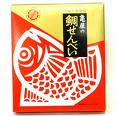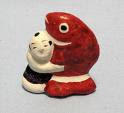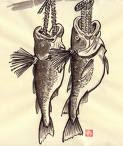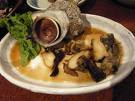::::::::::::::::::::::::::::::::::::::::::::::::::::::::::::::::::::::::::::::::::::::::::::::::::::
Sea urchin (uni)
***** Location: Japan
***** Season: Late Spring
***** Category: Humanity
*****************************
Explanation
uni 雲丹 (うに) sea urchin
"sea gall" uni 海胆(うに)
"sea chestnut" uni 海栗(うに)
The living animal is written with the Chinese characters for "sea gall 海胆", the salted roe is written with the characters "cloud crimson 雲丹 ".
It belongs to the family of Echinoidea.
The live mostly in shallow rocky beach areas, but further south they also live in the deep sea and some have poison.
In spring when the female are full of eggs the harvest is done from small boats with long sticks or tongues.
There are various ways to preserve the roe for eating during the year, but fresh in the season it is best.
The sperm is also eaten, even more expensive as the female parts. Small boards with the male organs are sold to highclass Sushi Bars.
Rohe weiche Seeigelrogen werden für den Verkauf nach der Größe sortiert und auf Holzbrettchen gelegt. Die männlichen Keimdrüsen sind eher weißlich und haben einen intensiveren Geschmack. Brettchen mit nur männlichen Keimdrüsen sind am teuersten und werden an Sushibars verkauft.
Dank ihres hohen Gehaltes an Mineralstoffen, insbesondere Jod, sind Seeigel wertvolle Nahrungsmittel und stehen im Ruf, auch der nachlassenden Manneskraft wieder auf die Sprünge zu helfen.
shirako 白子(しらこ. 魚精) milt, Milcher
Haiku are either about the living animal or about the delicious food.
. . . CLICK here for delicious Photos !
::::::::::::::::::::::::::::::::::::::::::::::::::::::::::::::::::::::::::::::::::::::::::::::::::::
Sea urchins are small, globular, spiny sea creatures, composing most of class Echinoidea. They are found in oceans all over the world. Their shell, or "test", is round and spiny, typically from 3 to 10 cm across. Common colors include black and dull shades of green, olive, brown, purple, and red. They move slowly, feeding mostly on algae. Sea otters, wolf eels, and other predators feed on urchins. Sea urchins are harvested and served as a delicacy.
Together with sea cucumbers (Holothuroidea), they make up the subphylum Echinozoa, which is defined by primarily having a globoid shape without arms or projecting rays.
Sea Urchins eat their food using a row of five teeth known as "Aristotle's Lantern" .
© More in the WIKIPEDIA !
:::::::::::::::::::::::::::::::::::::::::::::::::::::::::::::::::::::::::::::::::::::::::::::::::::::
akauni, aka-uni 赤海胆 red sea urchin
Roter Seeigel. Psudocentrotus depressus
It can live in rocky sear areas up to 90 meters deep. Its spines can grow about 8 cm.
. . . CLICK here for Photos !
bafununi, bafun uni 馬糞海胆, ばふんう "horse apple" sea urchin
„Pferdeapfel"-Seeigel Hemicentrotus pulcherrimus
Found from Hokkaido to Kyushu in rocky coastal areas. Used for sushi.
Best time (shun) is summer.
. . . CLICK here for Photos !
Ezo bafununi 蝦夷ばふんうに from Hokkaido
„Pferdeapfel“-Seeigel aus Hokkaido. Strongylocentrotus intermedius
Found from Hokkaido to the colder coasts of Northern Japan. Used for sushi.
Best time (shun) is from summer to autumn.
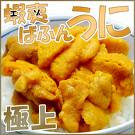
. bafunkaki 馬糞掻き horse-shit collectors in Edo .
- - - - -
gangaze がんがぜ / ガンガゼ long spined sea urchin
langstachliger Seeigel. Diadema setosum
longspine sea urchin. with poison
They are harvested off Hachinohe in Aomori from July to August.
In Kyushu, Minamata, they are harvested to protect the kelp from being eaten. Fishermen harvest them one by one with long poles, sitting in a boat with a goggle to watch the shallows.
The long spines are quite dangerous and difficult to remove.
The intestines are used to flavor Chanpon noodle soup, with a whipped egg on boiling tofu or just like that they are a local speciality, not seen on the market.
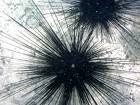
murasakiuni, murasaki uni 紫海胆 / ムラサキウニ
violet sea urchin
violetter Seeigel. Anthocidaris crassispina
Found in shallow rocky beach areas all over Japan. Speciality of Goto Retto Islands off Nagasaki.
Best time (shun) is summer.
Eaten as sushi, or salted or grilled.
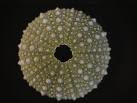
:::::::::::::::::::::::::::::::::::::::::::::::::::::::::::::::::::::::::::::::::::::::::::::::::::
One of the three chinmi Food specialities of Japan.
Chinmi, special delicasies 珍味
:::::::::::::::::::::::::::::::::::::::::::::::::::::::::::::::::::::::::::::::::::::::::::::::::::
Check here for regional specialities
Regional Dishes
Only the roe of the sea urchin is eaten.
うに料理 uni ryoori ... Dishes with sea urchin
karatsuki uni 殻つきウニ
fresh sea urchin out of the shell

with sea water for a natural flavor. Best eaten right on the beach.
Seeigel aus der Schale
namauni, nama-uni 生うに、生雲丹 raw sea urchin
. . . CLICK here for Photos !
roher Seeigel
neriuni, neri-uni 練雲丹 (ねりうに) "kneaded" sea urchin
for preservation, sold in bottles.
. . . CLICK here for Photos !
shiouni, shio-uni 塩うに salted sea urchin
for preservation, sold in bottles.
. . . CLICK here for Photos !
unidon うに丼 rice with fresh sea urchin

Warm rice with some chopped nori seaweeds, topped with raw sea urchin.
Reisschale mit Seeigel
unigunkan, uni gunkan うに軍艦巻き uni gunkan maki

The most popular shushi dish.
uni misojiru うにみそ汁 miso soup with sea urchin
Misosuppe mit Seeigel
tsubuuni, tsubu-uni 粒雲丹, 粒うに "drops of sea urchin"
for preservation, in bottles.
. . . CLICK here for Photos !
yakiuni, yaki-uni 焼きうに grilled sea urchin
. . . CLICK here for Photos !
gegrillter Seeigel
*****************************
Worldwide use
Seeigel
gesalzene Seeigeleier; Seeigeleierpaste; Seeigelcrème
*****************************
Things found on the way
*****************************
HAIKU
雲丹割くやおろかな日々の続きをり
uni saku ya oroka na hibi no tsuzukiori
cutting up sea urchins ...
these senseless days
continue
Kadokawa Minayoshi 角川源義 (1917 - 1975)
:::::::::::::::::::::::::::::::::::::::::::::::::::::::::::::::::::::::::::::::::::::::::::::::::::::
海胆怒る漆黒の棘ざうと立ち
uni okoru shikkoku no toge zatto tachi
the sea urchin gets angry ...
with a swoop it stands up
its spines
Hashimoto Keiji 橋本鶏二
:::::::::::::::::::::::::::::::::::::::::::::::::::::::::::::::::::::::::::::::::::::::::::::::::::::
珍客へまず山陰の雲丹を出し
chinkayku e mazu Sanin no uni o dashi
a special visitor ...
first thing is to offer him
sea urchin from Sanin
Imamura Yuji (Imamura Yuuji) 今村夕路
Tottori
Sanin "in the shadow of the mountains" is the area of the Sea of Japan along Tottori, Shimane and Yamaguchi, north of the Central Mountain Range.
:::::::::::::::::::::::::::::::::::::::::::::::::::::::::::::::::::::::::::::::::::::::::::::::::::::

うにの瓶何でこんなにぶ厚いの
uni no bin nan de konna ni buatsui no
a bottle of sea urchins ...
why is this bottle
so extra big?
Fumie 文江
*****************************
Related words
Chinmi, special delicasies
***** WASHOKU : FISH and SEAFOOD SAIJIKI
:::::::::::::::::::::::::::::::::::::::::::::::::::::::::::::::::::::::::::::::::::::::::::::::::::





